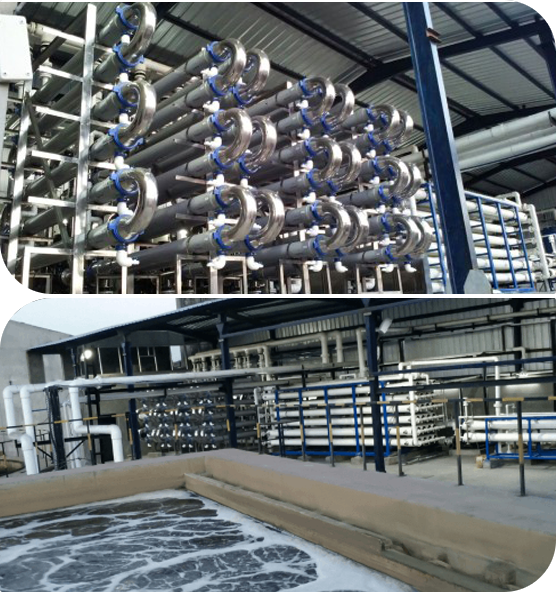
Waterman Engineers Australia is without doubt one of the major suppliers of Zero Liquid Discharge process. A ZLD procedure is a therapy procedure that is utilized to remove all the liquid squander from a method. The objective of ZLD h2o procedure is to lessen wastewater economically and make potable water that's fit for ordinary use. Zero discharge process is a sophisticated therapy process that comprises ultrafiltration, reverse osmosis, evaporation and fractional electro deionization. And we have been a nicely-known provider of ZLD methods.
In several Industries, including energy, oil & gasoline, chemicals, mining and Many others, a large amount of wastewater is created that has to be managed. Conventionally, this discharge of wastewater is completed via a plant outfall to your surface drinking water body like an evaporation pond, or in some instances deep perfectly injected. These procedures produce several environmental fears by the public in lots of areas of the world, as water is often a scarce resource and its management needs to be monitored. These problems have resulted within the establishment of ZLD processes by quite a few industries to reduce their environmental footprint and improve sustainability. And, Waterman Engineers Australia are best ZLD suppliers you could find for This technique.
PROPERTIES OF ZERO LIQUID DISCHARGE Method
The Homes of a Zero Liquid Discharge technique will vary based on the certain layout and technological know-how used. However, some typical Qualities of ZLD methods consist of:
Water Conservation: Certainly one of the primary objectives of ZLD units should be to preserve drinking water by minimizing the discharge of liquid squander in the setting.
Substantial Water Purity: ZLD systems are meant to develop substantial-good quality water that may be absolutely free from impurities and contaminants, which makes them suitable for use in several industrial processes.
Flexibility: ZLD techniques tend to be built to accommodate a wide array of enter liquid streams, which makes them multipurpose and appropriate for use in different industries.
State-of-the-art Wastewater Remedy: Zero liquid discharge units use Innovative wastewater treatment techniques to remove impurities and contaminants through the effluent, creating substantial-quality drinking water.
Squander Reduction: ZLD systems aid cut down waste by lowering the volume of liquid waste that needs to be disposed of and by developing a concentrated, strong waste substance which might be safely disposed of.
Strength Performance: ZLD units might be Electrical power-intense because of the substantial Electricity demands of evaporation as well as other wastewater remedy processes. Nonetheless, improvements in know-how are earning Zero liquid discharge units extra energy-economical and price-helpful.
Waterman Engineers Australia manufactures Zero Liquid Discharge (ZLD) devices built to clear away all liquid waste, aiming to supply potable water and minimize environmental effects. Their ZLD units commonly incorporate ultrafiltration, reverse osmosis, evaporation, and fractional electro deionization. Essential technologies made use of are Slipping Film Brine Concentrators, Compelled Circulation Crystallizer, and Other folks, using a two-step strategy of pre-concentration and evaporation/crystallization to Get better and reuse drinking water. These systems are adaptable to distinctive industries, emphasizing drinking water conservation, high drinking water purity, waste reduction, and Electricity efficiency. Complex specs are various and customizable, taking into consideration elements like h2o source, circulation rate, and feed drinking water quality.
The need for Zero Liquid Discharge (ZLD) units arises through the requirement to address environmental problems associated with drinking water scarcity and air pollution. In industries like energy, oil & gasoline, and mining, broad amounts of wastewater are generated. Ordinarily, this wastewater is discharged into bodies of h2o, creating pollution and depleting cleanse h2o resources. ZLD techniques intention to attenuate these impacts by managing and recycling wastewater inside the industrial approach, thus conserving h2o, lessening squander, and advertising sustainability.
When contemplating the complex requirements of a Zero Liquid Discharge (ZLD) technique, significant areas to focus on consist of the water source it will treat, the method's movement price, the quality of feed h2o, the levels of cure included, the recovery price of water, solutions for focus disposal, elements of building, working circumstances, and system automation and Command. These things ensure the method's effectiveness, longevity, and effectiveness in treating and recycling industrial wastewater.
Zero Liquid Discharge (ZLD) crops supply Advantages such as drinking water conservation, waste reduction, and air pollution prevention, contributing to environmental sustainability. They are applicable in industries like electric power era, oil and fuel, chemical substances, and mining, where they assist in handling industrial wastewater correctly, minimizing the ecological footprint, and complying with strict environmental restrictions. These methods are very important in places struggling with drinking water scarcity and for industries aiming to boost their sustainability and operational efficiency.
FAQs for the Zero Liquid Discharge (ZLD) system typically Zld System Manufacturer Zero Liquid Discharge System handle its operational principles, Charge-effectiveness, upkeep prerequisites, environmental influence, applicability across several industries, and regulatory compliance. These concerns support buyers comprehend the technique's Gains, technical demands, and suitability for their certain wastewater management desires.
one. Zero Liquid Discharge (ZLD) is usually a wastewater therapy method intended to do away with all liquid squander.
two. The process's parts are affected by the precise industrial system, wastewater composition, and regulatory necessities.
three. Effluent treatment method vegetation take away pollutants from textile effluents to avoid environmental contamination.
4. Positive aspects incorporate water conservation, pollution reduction, and regulatory compliance.
five. The target is to reduce environmental affect by recycling water and decreasing squander.
six-9. Effluent treatment crops are phases in wastewater remedy: Major (physical separation), secondary (Organic treatment method), and tertiary (Superior therapy).
ten. Unit functions include things like filtration, sedimentation, biological treatment, and disinfection.
11. Restricting parameters are variables that have an effect on the therapy's performance, like pH and contaminant concentration.
12. Design issues include stream price, effluent composition, and wished-for high-quality of treated drinking water.